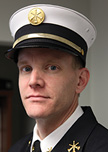Editor’s Opinion Chris Mc Loone
When looking at the present and future, I tend to look back to figure out how I got to where I am and what the progression will be for the future.

This month, our cover story explores walk-in vs. walk-around rescue trucks. It wasn’t that long ago, probably within the past 15 years, that we were comparing walk-in with walk-through rescues. Looking back at my own fire company, our progression has, like most, been charted by changing responsibilities.
When I joined Weldon Fire Company, our rescue truck was a 1989 Saulsbury rig built on a Spartan Gladiator cab and chassis. It was not a tilt cab. The crew cab held six personnel, four in pack seats facing rearward and two in flipdowns facing forward without self-contained breathing apparatus (SCBA). It was a walk-through rig—nothing better than sitting with the rear doors open. The rear body tunnel had SCBA seating for six more firefighters. The officer seat in the cab was not an SCBA seat, so if there was a captain or lieutenant riding the seat, and if it was a job, we’d hear the sliding window open, followed by, “Save me a pack!” When that truck was special called, we brought an army.
We had long reels for hydraulic lines that connected to vehicle-mounted pumps and hydraulic rescue tools mounted to the compartment doors. We carried cribbing in what we called “belly boxes.” It had a cascade system on it and a portable fill station. It had two light towers, but all they did was go up and down and rotate—straight up and straight down, and it took FOREVER for them to come back down. The year I joined, we were all certified in confined space rescue, and we needed to find space for new confined space rescue equipment. It was not our first foray into technical rescue, but the truck was really set up for vehicle rescue. It had two winches mounted to the vehicle, one in the front and one in the rear.
The next truck was another Saulsbury-built rig. It was a walk-in, but it just didn’t have rear doors. We lost a little bit of space in the back. We didn’t have as many people in the rear, but we increased the number of pack seats in the crew cab, and the officer now had a pack seat. We carried two extrication carts. These were two-wheeled carts that carried a hydraulic pump, two tools each, and hydraulic lines to connect them. All we needed was a cord reel for each cart to run the pumps. It helped a great deal not having the hydraulic lines tethered to the truck. We also carried an expanded assortment of technical rescue equipment, including equipment for trench and collapse as well as our existing confined space rescue equipment. Like the ’89, this truck also had a command center in the rear crew area.
Today we run a Rescue 1-built rescue. And, we’ve reduced the rear section of the walk-in even more. There is no more command center. The pack seats are in the crew cab and the officer seat only—not on the rear bench. Equipment-wise, we continue to carry technical rescue equipment as well as vehicle rescue equipment. Gone are the carts, but our equipment cache for vehicle rescue has increased. We shortened the interior crew area in the back to increase compartment space toward the rear. Will our next one be a walk-around? It’s possible.
Gone are the days of showing up with an army when the truck is special called, but, then again, the truck doesn’t get special called as often these days. Nowadays, it’s on the initial dispatch for most calls in the township. Like most volunteer fire companies in the United States, recruitment has become more of a challenge. We don’t need to accommodate 12 personnel in the back of the truck.
We took delivery of our current rescue in November 2016. It will be a little while before we replace it. I doubt the equipment cache will be smaller in the future than it is now. If anything, we’ll increase it as our scope of services continues to expand. I’m sure we will realistically look at how many personnel we intend to carry and plan accordingly. We’ll be building it to comply with National Fire Protection Association 1900, Standard for Aircraft Rescue and Firefighting Vehicles, Automotive Fire Apparatus, Wildland Fire Apparatus, and Automotive Ambulances. It might be the second edition by that time. And, we might find that because of the seating requirements of the standard, we need to keep an area in the body for pack seats because we might not be able to carry as many in the crew cab. And, of course, who knows what the cabs and chassis will be like by that time?
It’s always fun to look back at those early days and look with pride on where we are today accompanied by the excitement of what the future holds.

